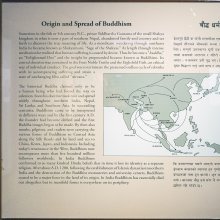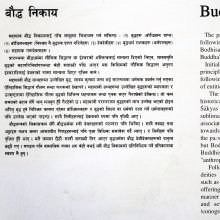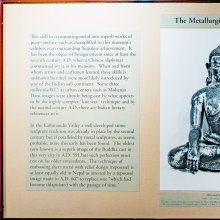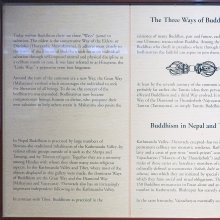Shakya, Sakya, Śākya, Sakyā: 25 definitions
Introduction:
Shakya means something in Buddhism, Pali, Hinduism, Sanskrit, the history of ancient India, Marathi, Hindi. If you want to know the exact meaning, history, etymology or English translation of this term then check out the descriptions on this page. Add your comment or reference to a book if you want to contribute to this summary article.
The Sanskrit term Śākya can be transliterated into English as Sakya or Shakya, using the IAST transliteration scheme (?).
Alternative spellings of this word include Shaky.
Images (photo gallery)
In Hinduism
Purana and Itihasa (epic history)
Source: Wisdom Library: Bhagavata PuranaŚākya (शाक्य):—Son of Sañjaya (son of Raṇañjaya). He will be born in the future and become a king. He will have a son called Śuddhoda. (see Bhāgavata Purāṇa 9.12.14)
Source: Cologne Digital Sanskrit Dictionaries: The Purana IndexŚākya (शाक्य).—A son of Sanjaya, and father of Śuddhoda (na).*
- * Bhāgavata-purāṇa IX. 12. 14; Matsya-purāṇa 271. 12; Vāyu-purāṇa 99. 288; Viṣṇu-purāṇa IV. 22. 8.

The Purana (पुराण, purāṇas) refers to Sanskrit literature preserving ancient India’s vast cultural history, including historical legends, religious ceremonies, various arts and sciences. The eighteen mahapuranas total over 400,000 shlokas (metrical couplets) and date to at least several centuries BCE.
Natyashastra (theatrics and dramaturgy)
Source: Wisdom Library: Nāṭya-śāstraŚākya (शाक्य) refers to “Buddhists”, whose mask should be represented as having a shaven head (śiromuṇḍa), according to Nāṭyaśāstra chapter 23. Providing masks is a component of nepathya (costumes and make-up) and is to be done in accordance with the science of āhāryābhinaya (extraneous representation).

Natyashastra (नाट्यशास्त्र, nāṭyaśāstra) refers to both the ancient Indian tradition (shastra) of performing arts, (natya—theatrics, drama, dance, music), as well as the name of a Sanskrit work dealing with these subjects. It also teaches the rules for composing Dramatic plays (nataka), construction and performance of Theater, and Poetic works (kavya).
Vyakarana (Sanskrit grammar)
Source: Wikisource: A dictionary of Sanskrit grammarŚakya (शक्य).—The substratum of potentiality which forms the object pointed out by means of the potentiality to the hearer by the word (i.e. शब्द (śabda)) which directly communicates the sense, in which case it is termed वाचक (vācaka) as contrasted with भेदक (bhedaka) or द्योतक (dyotaka) when the sense,which is of the type of संबन्ध (saṃbandha) is conveyed rather indirectly. This nice division into वाचकता (vācakatā) and भेदकता (bhedakatā) was introduced clearly by भर्तृहरिः (bhartṛhariḥ) cf. Vakyapadtya Kanda 2.

Vyakarana (व्याकरण, vyākaraṇa) refers to Sanskrit grammar and represents one of the six additional sciences (vedanga) to be studied along with the Vedas. Vyakarana concerns itself with the rules of Sanskrit grammar and linguistic analysis in order to establish the correct context of words and sentences.
Sports, Arts and Entertainment (wordly enjoyments)
Source: archive.org: Syainika Sastra of Rudradeva with English Translation (art)Śakya (शक्य) refers to “that which is easily attainable”, according to the Śyainika-śāstra: a Sanskrit treatise dealing with the divisions and benefits of Hunting and Hawking, written by Rājā Rudradeva (or Candradeva) in possibly the 13th century.—Accordingly, [while discussing the importance of hawks]: “[...] To possess the knowledge of what is practicable and of the means to achieve it, to discern what is easily attainable and what is not (śakya-aśakya-vivecana), to employ proper persons for proper works and dissuade them from doing what is improper, and such other qualities, which have been highly spoken of in politics [are considered also essential in the art of hawking]”.

This section covers the skills and profiencies of the Kalas (“performing arts”) and Shastras (“sciences”) involving ancient Indian traditions of sports, games, arts, entertainment, love-making and other means of wordly enjoyments. Traditionally these topics were dealt with in Sanskrit treatises explaing the philosophy and the justification of enjoying the pleasures of the senses.
In Buddhism
Theravada (major branch of Buddhism)
Source: Pali Kanon: Pali Proper NamesA tribe in North India, to which the Buddha belonged. Their capital was Kapilavatthu. Mention is also made of other Sakyan settlements e.g., Catuma, Khomadussa, Samagama, Devadaha, Silavati, Nagaraka, Medatalumpa, Sakkhara and Ulumpa (q.v.). Within the Sakyan tribe there were probably several clans, gotta. The Buddha himself belonged to the Gotamagotta. It has been suggested (E.g., Thomas, op. cit., 22) that this was a brahmin clan, claiming descent from the ancient isi Gotama. The evidence for this suggestion is, however, very meagre. Nowhere do we find the Sakyans calling themselves brahmins. On the other hand, we find various clans claiming a share of the Buddhas relics on the ground that they, like the Buddha, were khattiyas (D.ii.165). It is stated a that the Sakyans were a haughty people. Vin.ii.183; D.i.90; J.i.88; DhA.iii.163. Hiouen Thsang, however, found them obliging and gentle in manners (Beal, op. cit., ii.14).
When the Buddha first visited them, after his Enlightenment, they refused to honour him on account of his youth. The Buddha then performed a miracle and preached the Vessantara Jataka, and their pride was subdued. They evidently fond of sports and mention is made of a special school of archery conducted by a Sakyan family, called Vedhanna (D.iii.117; DA.iii.905). When the prince Siddhattha Gotama (later the Buddha) wished to marry, no Sakyan would give him his daughter until he had showed his proficiency in sport (J.i.58).
The Sakyans evidently had no king. Theirs was a republican form of government, probably with a leader, elected from time to time. The administration and judicial affairs of the gotta were discussed in their Santhagara, or Mote Hall, at Kapilavatthu. See, e.g., D.i.91; the Sakyans had a similar Mote Hall at Catuma (M.i.457). The Mallas of Kusinara also had a Santhagara (D.ii.164); so did the Licchavis of Vesali (Vin.i.233; M.i.228).
Ambattha (q.v.) once visited it on business; so did the envoys of Pasenadi, when he wished to marry a Sakyan maiden (see below). A new Mote Hall was built at Kapilavatthu while the Buddha was staying at the Nigrodharama, and he was asked to inaugurate it. This he did by a series of ethical discourses lasting through the night, delivered by himself, Ananda, and Moggallana. M.i.353f.; S.iv.182f; the hall is described at SA.iii.63; cf. UdA.409.
The Sakyans were very jealous of the purity of their race; they belonged to the Adiccagotta, (Adicca nama gottena, Sakiya nama jatiya, SN. vs.423) and claimed descent from Okkaka (q.v.). Their ancestors were the nine children of Okkaka, whom he banished in order to give the kingdom to Jantukumara, his son by another queen. These nine children went towards Himava, and, having founded Kapilavatthu (q.v. for details), lived there. To the eldest sister they gave the rank of mother,
Theravāda is a major branch of Buddhism having the the Pali canon (tipitaka) as their canonical literature, which includes the vinaya-pitaka (monastic rules), the sutta-pitaka (Buddhist sermons) and the abhidhamma-pitaka (philosophy and psychology).
General definition (in Buddhism)
Source: Buddhist Door: GlossarySakiya in Pali and Sakya in Sanskrit. The tribe to which Shakyamuni belonged.
Source: Shambala Publications: GeneralSakya (sa-skya-pa), Tib.; a major school of Tibetan Buddhism named after the Sakya (lit., “Gray Earth”) Monastery, located in southern Tibet. In accordance with a prophecy of Atīsha, the Sakya Monastery was founded in the year 1073, and its abbots, members of the Khön family, devoted themselves primarily to the transmission of a cycle of Vajrayāna teachings known by the name of “path and goal.” This school concerned itself with creating a systematic order for the tantric writings, but also turned its attention to problems of Buddhist logic. In the 13th and 14th centuries it had great political influence in Tibet.
India history and geography
Source: academia.edu: The Chronological History of Tibetan BuddhismSakya refers to one of the four major schools of Tibetan Buddhism.—Sakya is a city of Tibet. Atisa Dipankara travelled through this city. Khon Khonchog Gyalpo built the Sakya monastery in 413 CE (1073 CE – 660). Sachen Kunga Nyingpo, the son of Khon Khonchog Gyalpo was born in the Sakya monastery. He was the first of the following five Patriarchs of Sakya school. Sonam Tsemo, the son of Sachen Kunga Nyingpo was born in 482 CE.
- Sachen Künga Nyingpo (432-498 CE)
- Loppön Sonam Tsemo (482-522 CE)
- Jetsün Drakpa Gyaltsen (487-556 CE)
- Kunga Gyaltsen or Sakya Pandita (522-591 CE)
- Drogön Chogyal Phagpa (575-620 CE).
Interestingly, Sakya Lamas became the de-facto autonomous rulers of Tibet during the time of Mongol Yuan dynasty.
Source: Cologne Digital Sanskrit Dictionaries: Indian Epigraphical GlossaryŚākya.—(CII 1), a Buddhist; see Śākya-bhikṣu. Note: śākya is defined in the “Indian epigraphical glossary” as it can be found on ancient inscriptions commonly written in Sanskrit, Prakrit or Dravidian languages.

The history of India traces the identification of countries, villages, towns and other regions of India, as well as mythology, zoology, royal dynasties, rulers, tribes, local festivities and traditions and regional languages. Ancient India enjoyed religious freedom and encourages the path of Dharma, a concept common to Buddhism, Hinduism, and Jainism.
Languages of India and abroad
Pali-English dictionary
Source: BuddhaSasana: Concise Pali-English Dictionarysakya : (adj.) belonging to the Sākya race.
Source: Sutta: The Pali Text Society's Pali-English DictionarySakya, : see Dictionary of Names. In cpd. °puttiya (belonging to the Sakya son) in general meaning of “a (true) follower of the Buddha, ” A. IV, 202; Vin. I, 44; Ud. 44; a° not a follower of the B. Vin. III, 25. (Page 661)

Pali is the language of the Tipiṭaka, which is the sacred canon of Theravāda Buddhism and contains much of the Buddha’s speech. Closeley related to Sanskrit, both languages are used interchangeably between religions.
Marathi-English dictionary
Source: DDSA: The Molesworth Marathi and English Dictionaryśakya (शक्य).—a (S) Possible, practicable, feasible. 2 That may be conveyed by a particular word or phrase; that may be received as expressed or signified by it;--a sense or meaning.
Source: DDSA: The Aryabhusan school dictionary, Marathi-Englishśakya (शक्य).—a Possible, feasible.
Marathi is an Indo-European language having over 70 million native speakers people in (predominantly) Maharashtra India. Marathi, like many other Indo-Aryan languages, evolved from early forms of Prakrit, which itself is a subset of Sanskrit, one of the most ancient languages of the world.
Sanskrit dictionary
Source: DDSA: The practical Sanskrit-English dictionaryŚakya (शक्य).—pot. p.
1) Possible, practicable, capable of being done or effected (usually with an inf.); शक्यो वारयितुं जलेन हुतभुक् (śakyo vārayituṃ jalena hutabhuk) Bhartṛhari 2.11; R.2.49,54.
2) Fit to be effected.
3) Easy to be effected.
4) Directly conveyed or expressed (as the meaning of a word); शक्योऽर्थोऽभि- धया ज्ञेयः (śakyo'rtho'bhi- dhayā jñeyaḥ) S. D.1.
5) Potential.
6) Of agreeable or sweet address; 'शक्यः प्रियंवदः प्रोक्तः (śakyaḥ priyaṃvadaḥ proktaḥ)' इति हलायुधः (iti halāyudhaḥ); शक्यः संविभागशीलः (śakyaḥ saṃvibhāgaśīlaḥ) Daśakumāracarita 2.5. (The form śakyam is sometimes used as a predicative word with an inf. in a passive sense, the real object of the infinitive being in the nom. case; evaṃ hi praṇayavatī sā śakyamupekṣituṃ kupitā M.3. 22; śakyaṃ... aviralamāliṅgituṃ pavanaḥ Ś.3.6; vibhūtayaḥ śakyamavāptu- mūrjitāḥ Subhāś.; na hi dehabhṛtā śakyaṃ tyaktuṃ karmāṇyaśeṣataḥ Bhagavadgītā (Bombay) 18.11.).
--- OR ---
Śākya (शाक्य).—[śak-ghañ tatra]
1) Name of the family of Buddha.
2) Name of Buddha.
Derivable forms: śākyaḥ (शाक्यः).
Source: Cologne Digital Sanskrit Dictionaries: Edgerton Buddhist Hybrid Sanskrit DictionaryŚakyā (शक्या).—indecl. (= Pali, Prakrit sakkā; from Sanskrit root-aor. or precative śakyāt, Pischel 465), it is possible, one can (with inf.): śakyā etam evaṃ kartuṃ, yathā…Mahāvastu i.351.10; asmākaṃ punar naivaṃ śakyā mānsena kāryaṃ kartuṃ ii.213.9, but for us it is impossible thus to do what needs doing with meat; nāpi ca svayaṃkṛtānāṃ karmāṇāṃ phalaṃ (em.; if right, read phala m.c.) palāyituṃ śakyā 224.14 (verse); kiṃ śakyā kartuṃ 448.13, what is it possible to do ? (or pass., what can be done?); same 456.2; 457.5; na śakyā ma eṣāṃ (so read) bhūyo tatra mahānasaṃ visar- jayituṃ Mahāvastu i.363.14, it is impossible for me, after this, to have her sent there to the kitchen; na śakyā sarvam ākhyātuṃ iii.277.19 (or pass.); with passive force (influenced by śakya, adj.?), narakeṣu na mucyituṃ śakyā ii.223.13, in hells one cannot be freed (but, N.B., here the inf. is formed on the passive stem mucyate!). No certain case outside of Mahāvastu; śakyā kartuṃ candrādityau tamatimira…Lalitavistara 337.14 (verse) can better be taken as containing śakyā(ḥ), [Page521-1b+ 56] n. pl. (for dual); personal forms of adj. śakya in adjoining lines.
Source: Cologne Digital Sanskrit Dictionaries: Shabda-Sagara Sanskrit-English DictionaryŚakya (शक्य).—mfn.
(-kyaḥ-kyā-kyaṃ) 1. Possible, practicable to be effected or done, (generally with an inf.) 2. Fit to be effected or accomplished. 3. Directly expressed, (as the meaning of a word.) E. śak to be able, aff. yat .
--- OR ---
Śākya (शाक्य).—m.
(-kyaḥ) 1. Budd'Ha, the founder of the Baudd'ha religion. 2. The name of a tribe. E. śak to be able, and ṇyat, ghañ or yat aff.
Source: Cologne Digital Sanskrit Dictionaries: Benfey Sanskrit-English DictionaryŚākya (शाक्य).—m. Buddha, the founder of the Bauddha faith, [Daśakumāracarita] in
Śakya (शक्य).—[adjective] possible, feasible, practicable (infin. [with] pass. mg; [neuter] [impersonally], but also with a subject of any gender or number). Abstr. tā [feminine], tva [neuter]
--- OR ---
Śākya (शाक्य).—[masculine] [plural] [Name] of a warrior race, sgl. a man of this race, also = seq.
Source: Cologne Digital Sanskrit Dictionaries: Monier-Williams Sanskrit-English Dictionary1) Śakya (शक्य):—[from śak] mf(ā)n. able, possible, practicable, capable of being (with [infinitive mood] in pass. sense e.g. na sā śakyā netum balāt, ‘she cannot be conducted by force’; tan mayā śakyam pratipattum, ‘that is able to be acquired by me’; the form śakyam may also be used with a [nominative case] case which is in a different gender or number e.g. śakyaṃ śva-māṃsādibhir api kṣut pratihantum, ‘hunger can be appeased even by dog’s flesh etc.’; cf. [Vāmana’s Kāvyālaṃkāravṛtti v, 2, 25]), [Mahābhārata; Kāvya literature] etc.
2) [v.s. ...] to be conquered or subdued, liable to be compelled to ([infinitive mood]), [Mahābhārata]
3) [v.s. ...] explicit, direct, literal (as the meaning of a word or sentence, opp. to lakṣya and vyaṅgya), [Alaṃkāraśekhara, by Keśava-miśra]
4) Śākya (शाक्य):—mfn. derived or descended from the Śakas (= śakā abhijano sya) [gana] śaṇḍikādi
5) m. Name of a tribe of landowners and Kṣatriyas in Kapila-vastu (from whom Gautama, the founder of Buddhism, was descended), [Buddhist literature; Monier-Williams’ Buddhism 21, 22]
6) Name of Gautama Buddha himself, [Nyāyamālā-vistara]
7) of his father Śuddhodana (son of Saṃjaya), [Purāṇa]
8) a Buddhist mendicant, [Varāha-mihira’s Bṛhat-saṃhitā]
9) [patronymic] [from] śaka [gana] gargādi
10) [patronymic] [from] śāka, or śākin [gana] kurv-ādi.
Source: Cologne Digital Sanskrit Dictionaries: Yates Sanskrit-English Dictionary1) Śakya (शक्य):—[(kyaḥ-kyā-kyaṃ) a.] Possible, practicable.
2) Śākya (शाक्य):—(kyaḥ) 1. m. Buddha.
Source: DDSA: Paia-sadda-mahannavo; a comprehensive Prakrit Hindi dictionary (S)Śākya (शाक्य) in the Sanskrit language is related to the Prakrit word: Sakka.
[Sanskrit to German]
Sanskrit, also spelled संस्कृतम् (saṃskṛtam), is an ancient language of India commonly seen as the grandmother of the Indo-European language family (even English!). Closely allied with Prakrit and Pali, Sanskrit is more exhaustive in both grammar and terms and has the most extensive collection of literature in the world, greatly surpassing its sister-languages Greek and Latin.
Hindi dictionary
Source: DDSA: A practical Hindi-English dictionaryŚakya (शक्य) [Also spelled shaky]:—(a) feasible, possible, capable of being effected or done; ~[tā] feasibility, possibility.
...
Kannada-English dictionary
Source: Alar: Kannada-English corpusŚakya (ಶಕ್ಯ):—
1) [adjective] possible; practicable.
2) [adjective] explicit; literal (as the meaning of a word or sentence).
--- OR ---
Śakya (ಶಕ್ಯ):—
1) [noun] that which is possible.
2) [noun] the signification of a word.
--- OR ---
Śākya (ಶಾಕ್ಯ):—
1) [noun] Gautama Buddha, the founder of Buddhism.
2) [noun] the royal family of Gautama Buddha.
Kannada is a Dravidian language (as opposed to the Indo-European language family) mainly spoken in the southwestern region of India.
See also (Relevant definitions)
Starts with (+28): Sakyamuni, Shakyabhikshu, Shakyabhikshuka, Shakyabhikshuki, Shakyabodhisattva, Shakyabuddha, Shakyabuddhalokeshvara, Shakyabuddhi, Shakyaketu, Shakyakirti, Shakyam, Shakyama, Shakyamahabala, Shakyamata, Shakyamati, Shakyamitra, Shakyapala, Shakyaprabha, Shakyapratikara, Shakyapumgava.
Ends with: Anushakya, Ashakya, Dauhshakya, Drashtushakya, Duhshakya, Mahabalashakya, Mahashakya, Prashakya, Sashakya, Shakyashakya, Yathashakya.
Full-text (+319): Shakyasimha, Sakyamuni, Mahashakya, Suddhodana, Shakyapratikara, Ashakya, Shakyam, Shakyata, Shakyasamantata, Shakyabhikshu, Koliya, Shakyakirti, Suprabuddha, Drashtushakya, Gotamanvaya, Puttimant, Yavacchakyam, Bhadrika, Virudhaka, Shakyatva.
Relevant text
Search found 125 books and stories containing Shakya, Sakya, Śākya, Sakyā, Śakya, Śakyā; (plurals include: Shakyas, Sakyas, Śākyas, Sakyās, Śakyas, Śakyās). You can also click to the full overview containing English textual excerpts. Below are direct links for the most relevant articles:
Garga Samhita (English) (by Danavir Goswami)
Verses 6.21.24-25 < [Chapter 21 - In the Description of the Third Fort, the Glories of Piṇḍāraka-tīrtha]
Shrimad Bhagavad-gita (by Narayana Gosvami)
Verse 18.11 < [Chapter 18 - Mokṣa-yoga (the Yoga of Liberation)]
Verse 11.53 < [Chapter 11 - Viśvarūpa-darśana-yoga (beholding the Lord’s Universal Form)]
Verse 11.54 < [Chapter 11 - Viśvarūpa-darśana-yoga (beholding the Lord’s Universal Form)]
Brihad Bhagavatamrita (commentary) (by Śrī Śrīmad Bhaktivedānta Nārāyana Gosvāmī Mahārāja)
Verse 2.4.234 < [Chapter 4 - Vaikuṇṭha (the spiritual world)]
Verse 2.2.161 < [Chapter 2 - Jñāna (knowledge)]
Buddhist records of the Western world (Xuanzang) (by Samuel Beal)
Chapter 2 - Country of Kie-pi-lo-fa-su-tu (Kapilavastu) < [Book VI - Four Countries]
Chapter 1 - Country of Shi-lo-fu-shi-ti (Shravasti) < [Book VI - Four Countries]
Chapter 1 - Country of U-chang-na (Udyana) < [Book III - Eight Countries]
Bihar and Eastern Uttar Pradesh (early history) (by Prakash Narayan)
Nati (extended kin-group) < [Chapter 4 - Social Process, Structures and Reformations]
The Buddha and the Extended Kin-groups < [Chapter 4 - Social Process, Structures and Reformations]
Brother and Brother < [Chapter 4 - Social Process, Structures and Reformations]
The Vishnu Purana (by Horace Hayman Wilson)





